|
|
Touchstone

|
|
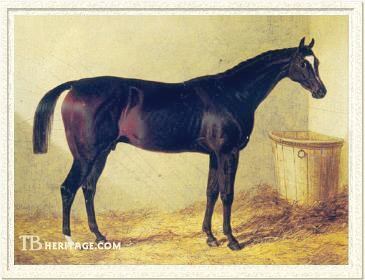 |
|
|
Touchstone was one of the the most influential sires of the nineteenth century, a leading sire four times, whose sons -- Orlando and Newminster -- grandsons --Lord Clifden, Adventurer, and Hermit -- and their male line descendants came in their turn to dominate the sire lists in the latter half of the 1800s and beyond. His most recent tail-male descendant to head the English sire list was the great stayer, Vaguely Noble (1973 and 1974), and in America, his tail-male descendant through Plaudit, Dr. Fager, led the sire list in 1977. Many of his daughters were productive and successful broodmares, and a number established their own branches of their dam's families through the success of their offspring. Touchstone is also seen in the pedigree of virtually all recent leading sires through Doncaster's dam, Marigold, the daughter of his grandson, Teddington.
Touchstone's dam, Banter, was bred by Robert, the (2nd) Earl of Grosvenor, later Marquis of Westminster, in 1826, from Boadicea (1807), an Alexander mare he had purchased from Lord Wilton. Boadicea had been used as a hunter up to 1819, although she had produced one filly, Brown Betty (1814) prior to her sale to Grosvenor. After joining the Grosvenor stud, she was bred to some of the day's top stallions, such as Orville, Whisker and Rubens, and the succession of daughters she produced for Grosvenor, including Etiquette (1820, by Orville) and Bertha (1821, by Rubens), established strong branches of Family 14.
Boadicea's brown, 15.2 hand daughter Banter, by Master Henry, was born in 1826, and won two races before being retired to the Grosvenor stud. Her first foal, to the cover of Camel, was Touchstone, born in 1831. His brother, Launcelot, born in 1837, was to win the Doncaster St. Leger in 1840. Banter's daughter Sarcasm (1833, by Teniers) was to produce another St. Leger winner, the sturdy Satirist (1838, by Pantaloon). Another daughter, Pasquinade (1839), sister to Touchstone and Launcelot, became an excellent producer and is seen tail-female in the pedigrees of such horses as brothers Sheshoon (1956) and leading sire Charlottesville (1957), and the influential grey Irish sire Tetratema and his brothers. Banter's daughter Jocose (1843), by Pantaloon, was the dam of Derby winner Macaroni, and was the tail-female ancestress of the influential racehorse and sire Polynesian; her unnamed sister (1844) was the tail-female ancestress of the top Australian stallion Grand Flaneur (1877) and of the good American racehorse Double Jay (1944). Thus Touchstone clearly had, in Banter, the seeds of an excellent heritage, which he was to send forward through his own sons and daughters.
His sire, Camel, by one of the pillars of the General Stud Book, Whalebone, had won a few races, including the two mile Port Stakes. A stocky, short-legged horse, his most distinctive features were his powerful quarters and thighs. He got a few other moderately successful horses, but it was Touchstone's success that made him a popular, if undistinguished sire. While in the possession of his breeder, Lord Egremont, he spent the 1830 season at the Grosvenor Eaton stud, which was when he got Touchstone on Banter. After that, he was sold to William Theobald, and stood thereafter at Theobald's Stockwell Stud near Clapham.
|
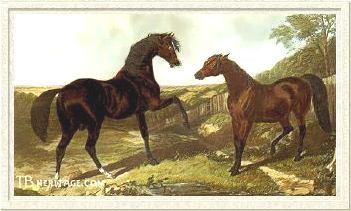
A romanticized version of Camel and Banter by J. F. Herring, engraved around 1844, a few years after both horses' deaths.
| |
Touchstone was reportedly a "frail-looking" foal. When grown, he stood 15.2 hands, the same height as his dam. He inherited the powerful hind end of his sire, and the long back of his dam -- he had nineteen dorsal vertebrae and a nineteen pairs of ribs. Somehow this odd, frequently unsound, and in the words of The Druid, "...in every way a very peculiar horse," became a good racehorse and top sire.
|
Touchstone on the Turf
Touchstone was, according to The Druid, "a very strange goer." With his turned-out hocks, he "...went so wide behind, that a barrel might have been placed behind his hind legs, when he was galloping." He ran with "a perfectly straight knee." He would always break slowly, but his great speed would take him to the lead, where his habit of hard pulling, even in his double reined bridle, would tax his jockeys' stamina, and he would instantly swerve if the whip was raised. Although he won at shorter distances, his metier was the longer races; he could, The Druid said, "stay for ever." At exercise, "he was very lazy, and could hardly be kicked along."
Touchstone was sent to Kirkley for training and made his debut at age two in a walk over for a sweepstakes at Lichfield, and in October ran third in the Champagne Stakes at Holywell Hunt, beaten by the good race filly Queen Bess and by Chateau Margeaux. In his first race at age three, the Dee Stakes at Chester, he beat Queen Bess and four others, and went on to win the Palatine Stakes, again beating Queen Bess. In his third race, the Liverpool St. Leger in July, he ran second to General Chassé, but held off Queen Bess and the good race horse Inheritor, among others.
After this, Grosvenor's son, Thomas, Lord Wilton, was approached by the "wizard of the north," trainer John Scott, who told him he felt sure he could school the horse to win the St. Leger at Doncaster in the fall, and so Touchstone was sent off to Scott's yard at Malton in Yorkshire. He was hand-walked the entire distance, and during the journey broke loose when his handler got drunk at a "house of call" on the moors; he was later found in "a sad state" after hours of wandering free.
Touchstone came to the St. Leger with a problematic near fetlock, of sufficient size to cause the jockey William Scott to refuse the ride on him in favor of Lady-de-Gros, who was ultimately unplaced. Touchstone, with Calloway up, started the race at odds of 40 to one. The year's top three year-old, Derby winner Plenipotentiary was the hot favorite, at odds of 11 to 10, but he had been overraced, and was probably deliberately poisoned before the race began, "dead beaten early in the race." After three false starts, the race broke with the gambler/owner Richard Watts' colt Bubastes in the lead, later pulled back by his jockey. Touchstone, given his head with 100 yards left in the race, easily came home first by four lengths, despite being "amiss." He did not start the following day for the Doncaster Cup. His St. Leger win was followed by a win in a small race at Wrexham. His final race of his three year-old year was the Mostyn Stakes over the Mostyn mile at Holywell Hunt, and was again beaten there, placing third to Intriguer and Birdlime, the latter a decent horse who went on to win the Chester and Liverpool Cups in succeeding years.
At age four, Touchstsone began his year with a walk-over for the Stand Cup. He failed to place in the Liverpool Cup, then won the prestigeous Doncaster Cup, with jockey William Scott in the saddle, beating the good horses Hornsea (at 7 st.) and General Chassé(who carried the same weight as Touchstone, 8 st. 3 lbs.), among others. He then went on to win a gold plate and sweep at Heaton Park, ridden by Thomas Egerton (Grosvenor), Lord Wilton. This was followed by a walk over for a Gold Cup and a sweepstakes. Returning for a third time to Holywell Hunt, and a second time to the Mostyn Stakes, he ran second, this time beaten by the filly Usury, in part due to his swerving to avoid the whip his jockey, Calloway, had tried to finesse behind his back during the running. The season ended with another walk over for 130 sovereigns.
|
|
Touchstone's Classic Winners
|
| Year |
Name |
Classic Races Won |
| 1842 |
Blue Bonnet, b.f. out of Maid of Melrose |
St. Leger |
| 1843 |
Cotherstone, b. c. out of Emma by Whisker |
Derby, 2,000 Guineas |
| 1844 |
Orlando, b.c. out of Vulture by Langar |
Derby |
| 1846 |
Mendicant, br.f. out of Lady Moore Carew by Tramp |
Oaks, 1,000 Guineas |
| 1848 |
Surplice, b.c. out of Crucifix by Priam |
Derby, St. Leger |
| 1848 |
Flatcatcher, b.c. out of Decoy by Filho da Puta |
2,000 Guineas |
| 1849 |
Nunnykirk, bl.c., out of Beeswing by Dr. Syntax |
2,000 Guineas |
| 1851 |
Newminster, b.c. out of Beeswing by Dr. Syntax |
St. Leger |
| 1855 |
Lord of the Isles, b.c. out of Fair Helen by Pantaloon |
2,000 Guineas |
| Total |
-- |
12 |
|
Touchstone led the sire's list four times in Great Britain, in 1842, 1843, 1848 and 1855. His offspring varied in size and conformation, and with a few notable exceptions, most did not inherit his tendency to stay, nor were they noted for good movement. He left behind over thirty sons who went to stud -- of them, Orlando, considered the most beautiful of his get, led the sires list three times and Newminster headed the list twice. Touchstone attracted the best mares of his time, and was able to make the most of these opportunities. Among the top race mares sent to him were Oaks and Coronation Stakes winner Ghuznee, dam of Assault and Attack; four-time Doncaster Cup winner Beeswing, dam of Nunnykirk and Newminster; triple classic winner Crucifix, dam of Surplice. He also got good racing daughters, among them dual classic winner Mendicant (1843) and Blue Bonnet (1839), who won the St. Leger Stakes, and many top producing daughters, including Mowerina (1843), the dam of English Triple Crown winner West Australian.
Beeswing, by Dr. Syntax, was an outstanding race mare who ran and won to the age of nine. She met Touchstone on the race course in her first run for the Doncaster Cup at age 3, a race he won, and she would win four times. She was bred four times to Touchstone. Her first son by him was the black NUNNYKIRK (1846), who won the Two Thousand Guineas Stakes and one other good race, and was sold to France in 1851, where he stood at stud. Sisters HONEY-DEW (1850) and HONEY-SUCKLE (1851) were both good producers, the latter tail-female ancestress of 1888 Derby and Two Thousand Guineas Stakes winner Ayrshire, 1882 Derby and St. Leger winner Melton, and a host of other good horses springing from her daughter, Woodbine's, branch of Family 8.
|
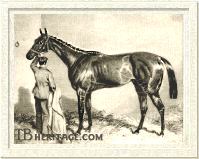
St. Leger winner Newminster, from the great race mare Beeswing, was twice Leading Sire
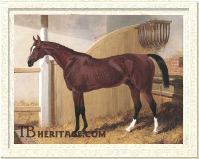
Derby winner Orlando, from the fast Vulture, led the sire's list three times
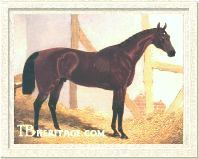
Dual classic winner Cotherstone, whose sister, Mowerina, was dam of Triple Crown winner West Australian
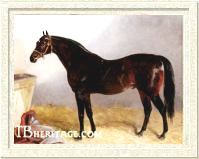
Surplice at stud
| |
Beeswing's second son by Touchstone, the bright bay NEWMINSTER (1848), won the St. Leger and the Goodwood Cup and was twice leading sire in England, with many good sire sons who bred on for a few generations, and two sons who became tail-male conduits to outstanding racehorses and sires of the 19th and 20th centuries. St. Leger winner Lord Clifden (1860) was one, who through son Hampton (1872) established a line that included Dark Ronald, Ayrshire, Ambassador IV, Son-in-Law, Gainsborough and son Hyperion, and many others. The second was Derby winner Hermit (1864), who led the sires list seven times, and from whom descended in tail-male horses such as the great jumper sire Ascetic (1872), the French sire Sans Souci II, and St. Blaise, who was a sucessful sire in the U.S. Hermit was also an excellent race filly and broodmare sire, with four classic winning daughters. The Newminster son Adventurer, who led the sire's list in England in 1874, sired Derby winner Pretender (1866) and classic winning fillies. Another Newminster son, July Stakes winner Cambuscan, got the lovely sherry-bay Camballo (1872), who won the Two Thousand Guineas, and the unbeaten great race mare Kincsem (1874).
The speedy Langar daughter Vulture (1833) produced the Derby winner ORLANDO (1841) to Touchstone. A handsome bay horse with excellent conformation and a "bloodlike" head, he later led the leading sires list in England three times. One son, Derby winner Teddington, sired Doncaster's dam, Marigold. His other sons included July Stakes winner Marsyas (1851), sire of Derby winner George Frederick and stakes winner Albert Victor, both of whom bred on; Trumpeter (1856), tail-male grandsire of the first French horse to lead the English sires list, Flageolet (1870); Canary (1858), whose line extended in tail-male several successful generations. Orlando's most important son was Morris' Eclipse (1855), who was sent to the U.S. and became the tail-male grandsire of Himyar, the sire of the Americans Plaudit and the great racehorse and sire Domino.
The third Touchstone son who made a long-lasting impact on the breed was the dark brown ITHURIAL (1841), out of the Velocipede daughter Verbena. He won the Liverpool St. Leger and Goodwood's Gatwicke Stakes, among other races, despite being a roarer, an unsoundness he transmitted to his progeny, including his son, Longbow, who won some races, but was also a roarer, and Longbow's son Toxophilite, who also was a bleeder. Toxophilite's son, Musket, was sent to stud in New Zealand after a modest racing career in England, where he got Trenton (1881) and Melbourne Cup winner Carbine (1885), both of whom were brought back to England to sire classic winners. The most notable Carbine son was Derby winner Spearmint, who later sired another Derby winner in his son Spion Kop.
|
From the Whisker daughter, Emma, Touchstone sired COTHERSTONE (1840), who won the Derby and the Two Thousand Guineas Stakes, and MOWERINA (1843), dam of the first English Triple Crown champion, West Australian. Emma also produced a Derby winner in Mundig, who was by Catton. Cotherstone did not produce a good sire son, but got some good daughters, including Pandora, dam of St. Leger winner and sire St. Albans. In addition to producing West Australian, Mowerina became third dam in tail-female descent of her namesake, Mowerina (1876) by Scottish Chief, dam of Derby winner and sire Donovan, by Galopin, and One Thousand Guineas winner Semolinaby St. Simon.
Touchstone's son SURPLICE (1845) came from the Priam daughter Crucifix, the best of her generation, who had won the Epsom Oaks and the One Thousand and Two Thousand Guineas Stakes. Surplice won both the Derby and the St. Leger. Like Cotherstone, he did not get any significant sons in England, although one, the French-bred Florin (a half-brother to Dollar), won the French Two Thousand Guineas. His daughters included Eastern Princess, the dam of the beautiful and popular Prince Charlie, who won 25 of his 29 races, including the Two Thousand Guineas Stakes.
Touchstone's son FLATCATCHER (1845), who won the Two Thousand Guineas, later sired Jeu d'Esprit, important in Family 7. Flatcatcher's dam, Decoy, by Filho da Puta, also produced the filly PHYRNE to Touchstone, who produced several winners that bred on, including the lovely Hobbie Noble (1849, by Pantaloon), a good juvenile racer.
Another Touchstone son, the bay LORD OF THE ISLES (1852), also won the Two Thousand Guineas Stakes, the Lavant Stakes and several other good races. His sire line continued for several generations through sons Scottish Chief (1861) and Dundee (1858). His dam, Fair Helen, by Pantaloon, was a half sister to the great race mare Alice Hawthorn. To Touchstone, Fair Helen also produced LADY MACDONALD (1858), who was dam of the Oaks winner Brigantine.
Touchstone's Daughters
|
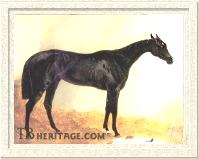
Mendicant
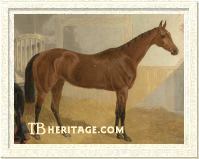
Blue Bonnet
| |
Touchstone's best daughter on the turf was MENDICANT (1843), who won both the Epsom Oaks and the One Thousand Guineas Stakes, and other races to age 4. She was out of the Tramp daughter, Lady Moore Carew. In the stud she produced Derby winner Beadsman (1855, by Weatherbit), who went on to sire St. Leger winner Pero Gomez, Derby winner Blue Gown, and brothers Rosicrucian (Criterion Stakes) and The Palmer (Ascot Derby). She also produced Vaga, dam of One Thousand Guineas winner Belphoebe, and of Stray Shot, who heads her own branch of Family 13.
BLUE BONNET (1839), out of the Brutandorf mare Maid of Melrose had shown great promise as a two year old in trials, although she broke down twice before getting to the races; she debuted in public in the Doncaster St. Leger, which she won under heavy punishment from her jockey, Tommy Lye, and although she ran second in the Park Hill Stakes after that, she was essentially finished as a racehorse, and at age 4, running in a stakes at Doncaster, she threw her rider and bolted "clean away." She was not particularly successful as a broodmare, but her son, Bonnie Dundee (1848, by Lanercost) was one of the first two thoroughbred stallions to be imported into Argentina, around 1853, and through his half-bred progeny was an important contributor to the development of racing in that country: The Argentine Family Ar-1, which had Argentine classic winners through the twentieth century, has a half-bred Bonnie Dundee daughter as its taproot.
|
Touchstone's daughter CINIZELLI (1842), from the Pantaloon mare Brocade, produced the Epsom Oaks winner Marchioness (1852) and The Marquis, winner of the Two Thousand Guineas and the St. Leger Stakes, and other good horses.
Oaks winner Ghuznee, by Pantaloon, was bred by Lord Grosvenor from the Cain mare Languish, and she was retired to his stud after her three year old year, where she was bred almost exclusively to Touchstone. From her sprang three sturdy branches of Family 20, via her daughters ESCALADE (1846) and MEANEE (1844), both by Touchstone. Prix du Jockey Club winner and good French sire Heume (1887, by Hermit), and Oaks Stakes winner Jenny Howlett (1877, by The Palmer) descended from her Touchstone daughters.
THE PRAIRIE BIRD (1844) by Touchstone heads her own branch of Family 1. Silvio (1874, by Blair Athol), who won the Derby and the St. Leger and other top races, and became and leading sire in France, and St. Leger winner Hawthornden (1867, by Touchstone grandson Lord Clifden), sprang from this branch of the family. VEXATION (1845), by Touchstone out of Vat, was another Family 1 member, who, when bred to Mendicant's son, Beadsman, produced the Derby winner Blue Gown. Touchstone bred many more daughters -- some mentioned with their brothers above -- who became ancestresses of good racehorses and are spread widely throughout the various female families that comprise the thoroughbred breed today.
--Patricia Erigero
|
|
|
|

